| Srl | Item |
| 1 |
ID:
122673
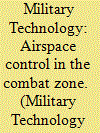

|
|
|
|
|
| Publication |
2012.
|
| Summary/Abstract |
The airspace of the combat zone is a crucial part of the battlespace and is used by all components of the joint and multinational forces. A high con- centration of friendly surface, sub- surface, and air-launched weaponsystems must share this airspace without unnecessarily hindering the application of combat power.
The primary goal of combat zone airspace control is to enhance the combat effectiveness of the joint force. Airspace control includes coordinating, integrating, and regulating airspace to increase
operational effectiveness
|
|
|
|
|
|
|
|
|
|
|
|
|
|
|
|
| 2 |
ID:
122662
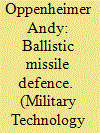

|
|
|
|
|
| Publication |
2012.
|
| Summary/Abstract |
The current generation of ballistic missile defence (BMD) system is intended to defence Europe against rogue state threats expected in the near future- launched missile threats from the Middle East, most notable Iran and the protect the US from medium and long range missiles from North Korea and other nascent WMD wielding states.
|
|
|
|
|
|
|
|
|
|
|
|
|
|
|
|
| 3 |
ID:
122663
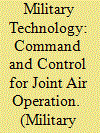

|
|
|
|
|
| Publication |
2012.
|
| Summary/Abstract |
This article provides joint doctrine for the C2 of joint air operation across the range of military operations and discussed responsibilities of a joint force air component commander (JFACC). It sets forth joint doctrine to govern the activities and performance of the US armed forces in joint operation and providers the doctrinal basis for inter-agency coordination and for US military involvement in multinational operations
|
|
|
|
|
|
|
|
|
|
|
|
|
|
|
|
| 4 |
ID:
122668
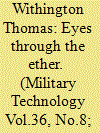

|
|
|
|
|
| Publication |
2012.
|
| Summary/Abstract |
During the Second World War, the nascent science of RADAR was chiefly concerned with the fixed wing aircraft threat. Over 60 years later, today's air surveillance radars have to keep watch not only fro planes but for helicopters, UAVs cruise missiles, and precision guided munitions. These radars have to be sufficiently robust and provide a low probability of intercept (LPI) to frustrate signals intelligence (SIGINT) collection, and Anti Radiation Missiles (ARMs).
|
|
|
|
|
|
|
|
|
|
|
|
|
|
|
|
| 5 |
ID:
122671


|
|
|
|
|
| Publication |
2012.
|
| Summary/Abstract |
The persistence of the sensor in question is to large degree of function of the platform's capabilities and the many cases, the desire for cost effectiveness has lead to modular architectures allowing multiple different payloads to be installed from mission to mission and in other cases, upgrades over the extended lifetime of the platform.
|
|
|
|
|
|
|
|
|
|
|
|
|
|
|
|
| 6 |
ID:
122672
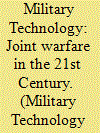

|
|
|
|
|
| Publication |
2012.
|
| Summary/Abstract |
The document "Capstone Concept
for Joint Operations" describes in
broad terms the vision of the then
Chairman of the Joint Chiefs of
Staff, Adm. Michael G. Mullen for
how the joint force circa 2016-2028
will operate in response to a wide
variety of security challenges. It
proposes that future joint force
commanders will combine and
subsequently adapt some combi-
nation of four basic categories of
military activity - combat, security,
engagement, and relief and recon-
struction - in accordance with the
unique requirements of each oper-
ational situation. The concept is
informed by last years, still current,
strategic guidance, but because it
looks to the future, it is intended to
be adaptable to changes in that
guidance.
|
|
|
|
|
|
|
|
|
|
|
|
|
|
|
|
| 7 |
ID:
122661


|
|
|
|
|
| Publication |
2012.
|
| Summary/Abstract |
Lt. General Richard P Formica was commissioned in 1997 upon completion of ROTC at providence college and graduation from Bryant college in Smithfield, RI. He graduated from the field artillery Officer basis and Advanced courses and cannon Battery Officer courses. He is a 1990 graduate of the Army command and General Staff college, where he earned a Master of Military Arts and Sciences. He graduated from the National War College in 1997 and earned a master's degree in National Security Strategy. Lt.Gen. Formica assumed command of the US army Space and Missile Defence Command /Army forces Strategic Command and joint functional component command integrated missile defence on 15th December 2010.
|
|
|
|
|
|
|
|
|
|
|
|
|
|
|
|
| 8 |
ID:
122670
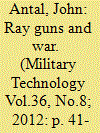

|
|
|
|
|
| Publication |
2012.
|
| Summary/Abstract |
Active denial technology, like the heavy expanded mobility tactical truck : Ray Gun" shown, give solders something more persuasive than shouting but less harmful than shooting when dealing with potentially hostile crowds. This state-of-art millimeter wave system developed by the joint non lethal weapons directorate, give soldiers something more persuasive than shouting, but less harmful than shooting, when dealing with potentially hostile crowds. US DoD experts displayed the system during a demonstration in March 2012
|
|
|
|
|
|
|
|
|
|
|
|
|
|
|
|
| 9 |
ID:
122669
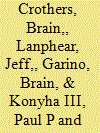

|
|
|
|
|
| Publication |
2012.
|
| Summary/Abstract |
Intelligence surveillance and reconnaissance (ISR) is the collection of data and information on the object
or in the area of interest (AOI) on a continuing event driven or scheduled basis.
|
|
|
|
|
|
|
|
|
|
|
|
|
|
|
|
| 10 |
ID:
122674
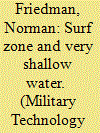

|
|
|
|
|
| Publication |
2012.
|
| Summary/Abstract |
Why are littoral operations so difficult? What is particularly bad about very shallow water (VSW). Leading up to and including the surf zone (S2)? The reference is always to mine countermeasures (MCM) in an amphibious context, because otherwise ships can and should evade really shallow water. MCM close to and on the beach always seem to involve technology very different from what is needed in even slightly deeper water. Many navies otherwise skilled in MCM lack such techniques. because they are concerned mainly with keeping harbours open in the face of enemy mining rather than in supporting amphibious operations. Only a few Navies have invested in the ability to land despite resistance. including mines.
|
|
|
|
|
|
|
|
|
|
|
|
|
|
|
|